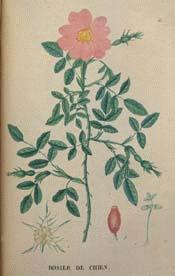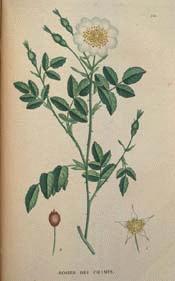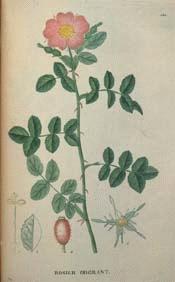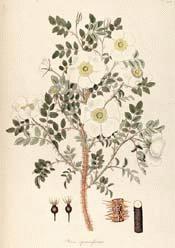 |
(Hyssopus officinalis LINN.) Click on graphic for larger image |
- The DOG ROSE (R. canina) is a flower of the early summer, its blossoms expanding in the first days of June and being no more to be found after the middle of July. The general growth of the Dog Rose is subject to so much variation that the original species defined by Linnaeus has been divided by later botanists into four or five subspecies. The flowers vary very considerably in colour, from almost white to a very deep pink, and have a delicate but refreshing fragrance. The scarlet fruit, or hip (a name that has come down from the Anglo-Saxon hiope), is generally described as 'flask-shaped.' It is what botanists term a false fruit, because it is really the stalk-end that forms it and grows up round the central carpels, enclosing them as a case; the real fruits, each containing one seed, are the little hairy objects within it. Immediately the flower has been fertilized, the receptacle round the immature fruits grows gradually luscious and red and forms the familiar 'hip,' which acts as a bait for birds, by whose agency the seeds are distributed. At first the hips are tough and crowned with the fivecleft calyx leaves, later in autumn they fall and the hips are softer and more fleshy. The pulp of the hips has a grateful acidity. In former times when garden fruit was scarce, hips were esteemed for dessert. Gerard assures us that 'the fruit when it is ripe maketh the most pleasante meats and banketting dishes as tartes and such-like,' the making whereof he commends 'to the cunning cooke and teethe to eate them in the riche man's mouth.' Another old writer says:
- 'Children with great delight eat the berries thereof when they are ripe and make chains and other pretty geegaws of the fruit; cookes and gentlewomen make tarts and suchlike dishes for pleasure.'
Rose hips were long official in the Pritish Pharmacopceia for refrigerant and astringent properties, but are now discarded and only used in medicine to prepare the confection of hips used in conjunction with other drugs, the pulp being separated from the skin and hairy seeds and beaten up with sugar. It is astringent and considered strengthening to the stomach and useful in diarrhoea and dysentery, allaying thirst, and for its pectoral qualities good for coughs and spitting of blood. Culpepper states that the hips are 'grateful to the taste and a considerable restorative, fitly given to consumptive persons, the conserve being proper in all distempers of the breast and in coughs and tickling rheums' and that it has 'a binding effect and helps digestion.' He also states that 'the pulp of the hips dried and powdered is used in drink to break the stone and to ease and help the colic.' The constituents of rose hips are malic and citric acids, sugar and small quantities of tannin, resin, wax, malates, citrates and other salts.
The leaves of the Dog Rose when dried and infused in boiling water have often been used as a substitute for tea and have a grateful smell and sub-astringent taste. The flowers, gathered in the bud and dried, are said to be more astringent than the Red Roses. They contain no honey and are visited by insects only for their pollen. Their scent is not strong enough to be of any practical use for distillation purposes.
Two explanations have been put forward for the popular name of this wild rose. The first is founded on an ancient tradition that the root would cure a bite from a mad dog (Pliny affirming that men derived their knowledge of its powers from a dream); and the other and more probable theory that it was the Dag Rose - 'dag' being a dagger - because of its great thorns, and like the 'Dogwood' (originally Dagwood) became changed into 'Dog' by people who did not understand the allusion.
FIELD ROSE
 |
(Rosa arvensis) Click on graphic for larger image |
The FIELD ROSE (R. arvensis) is generally a much more trailing rose than the Dog Rose, a characteristic which distinguishes it from all our other wild roses. It is widely distributed throughout England, but is much less common in Scotland and Ireland.
The leaves in general form are similar to those of the Dog Rose, but are often rather smaller and their surfaces more shining. The prickles, too, are somewhat smaller in size, but are more hooked. The flowers are white, much less fragrant than those of the Dog Rose and sometimes even scentless. Though occasionally occurring singly on the stem, they are generally in small bunches of three or four at the ends of the twigs, though only one of these at a time will as a rule be found expanded. This species generally comes into blossom rather later than the Dog Rose and continues in bloom a good deal longer. It is one of the chief ornaments of our hedge-rows, in the summer, from the profusion of its blossoms and long trailing stems; and in the autumn, by its scarlet hips, which are more globular in form than those of the Dog Rose. It has its styles united into a central column and not free or separate, as in the Dog Rose.
SWEET BRIAR
 |
(Rosa eglanteria printed as Rosa rubiginosa) Click on graphic for larger image |
The flowers of the Sweet Briar are a little smaller than those of the Dog Rose and generally of a deeper hue, though of a richer tint in some plants than in others. They are in bloom during June and July. The fruit is eggshaped, its broadest part being uppermost or farthest from the stem.
The specific name rubiginosa signifies, in Latin, 'rusty,' the plant having been thus named as both stems and leaves are often of a brownish-red tint. It delights in open copses, though is sometimes found also in old hedgerows and is more specially met with in chalk districts in the south of England.
Its fragrance of foliage is peculiarly its own and has led to it holding a cherished place in many old gardens. Under its older name of Eglantine its praises have been sung by poets.
It takes a shower to bring out the full sweetness of Sweet Briar, when its strong and refreshing fragrance will fill the air and be borne a long distance by the breeze. Though the leaves are so highly odorous, the flowers are almost entirely without scent.
Sweet Briar only obtains a place among perfumes in name, for like many other sweetscented plants, it does not repay the labour of collecting its odour, the fragrant part of the plant being destroyed more or less under treatment. An Essence under this name is, however, prepared, compounded of various floral essences so blended as to resemble the spicy fragrance of the growing plant. In olden days the Sweet Briar was used medicinally.
Briarwood pipes are not made from thewood of either the Sweet Briar or of any wild rose, but from that of the Tree Heath (Erica arborea).
BURNET ROSE
 |
(Rosa pimpinellifolia printed as Rosa spinosissima) Click on graphic for larger image |
The BURNET ROSE (R. spinosissima), known also as the Pimpernel Rose, or Scotch Rose, is generally found on waste land near the sea, more rarely on dry, heath-clad hills inland. The whole plant rarely attains to more than a foot or so in height. Its stems are armed with numerous, straight thorns - hence its specific name, signifying in Latin 'exceedingly prickly.' The English name is given it from the fact that the general form of its small leaves, with seven or nine leaflets to each leaf, is very similar to those of the Burnet (Poterium sanguisorba) and the Burnet Saxifrage (Pimpinella).
The white or sulphur-tinted flowers are usually placed singly and are rather small. The roundish fruit is so deep a purple as to appear almost black. The juice of the ripe fruit has been used in the preparation of dye: diluted with water, it dyes silk and muslin of a peach colour and mixed with alum gives a beautiful violet, but is considered too fugitive to be of any real economic value.
This rose is frequently cultivated in gardens and a great many varieties have been raised from it. The first double variety was found in a wild state in the neighbourhood of Perth and from this one were produced about 50 others. The French have over 100 distinct varieties.
 Botanical: Rosa villosa
Botanical: Rosa villosaThe DOWNY ROSE (R. villosa) is found only in England in the north and west, but is common in Scotland, Ireland and Wales. It receives its specific name from the downy texture of both sides of the leaves, the Latin word villosa meaning softly hairy.
This species is subject to many variations, five or six of which have been by some botanists considered separate species. The flowers are white or pale pink. The fruit, which is globular, is covered with fine prickles.
The stems of the various kinds of wild rose are often found tufted with little fluffy balls of what look like crimson moss. These are really galls and result from the puncture of a small insect, a kind of wasp - the Rose Gall - in a similar manner as Oak Galls are formed. The wasp punctures a leaf while it is yet undeveloped in the bud and there lays its eggs. Immediately the normal growth of the leaf alters and numerous larvae are formed, which hatch out and creep further into the leaf tissues until the whole swells into the moss-like gall we know. In the Middle Ages these Rose Galls, under the name of Bedeguar, were held in high repute in medicine for their astringency and supposed power of inducing sleep if placed under the pillow at night.


No hay comentarios.:
Publicar un comentario